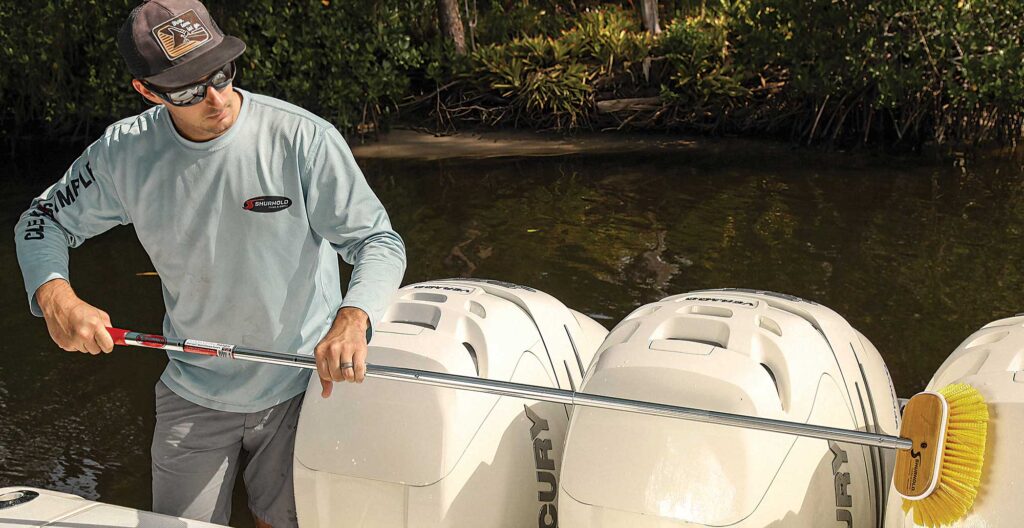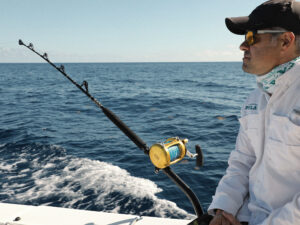
Everyone wants a clean boat, but using the wrong technique or cleaning product can cause damage. One of the purposes of cleaning a boat is to protect your investment, and sometimes good old elbow grease is better than using more extreme methods that might be faster but harmful. Here are seven no-nos of boat cleaning.
Waiting Too Long
Stains from fish blood allowed to dry can be challenging to remove. When the fish are biting, it’s easy to forget to stay on top of the blood and gruel that can accumulate. Whenever you gaff a fish or land one that’s badly hooked, take a few seconds to spray any blood with the raw-water washdown. The same goes for any nastiness left over when using cut bait. Hose it down and scrub it quickly while still on the water.
When you get in, start with a quick freshwater prewash rinse. Then, in sections, first start at the top and work down to the deck using a foam cannon to disperse the suds evenly, then scrub with a boat-washing mitt or a soft-bristle brush. If you use a bucket, get one with a raised grate at the bottom so dirt and sand particles can fall to the bottom and won’t cling to the mitt or brush when it’s dipped in the sudsy water. Next, thoroughly rinse the boat with fresh water. Wipe down with a chamois, faux-chamois or clean microfiber towel to prevent hard-water spots.
Harsh Chemicals
Household cleaners with alcohol, ammonia or petroleum products can harm many different surfaces on a boat. Professionals sometimes use chemicals like citric acid, oxalic acid or even muriatic acid for extreme situations, but these chemicals can be dangerous and destructive to boat finishes in the hands of untrained or inexperienced individuals. When washing the boat, it’s better to stick to gentle solutions before turning to harsh chemicals. For example, use a quality boat-specific product like Star brite Boat Wash or Meguiar’s Boat Wash instead of a degreaser soap like Dawn, which can strip away protective wax. For nonskid surfaces, use Star brite Deck Cleaner.
Abrasive Scrubbers
While Scotch-Brite pads and melamine foam sponge products like Magic Erasers are effective for removing scuff marks and tough stains, they are abrasive and can scratch gelcoat and surfaces such as powder coating. Brushes with white bristles are usually the stiffest and can also scratch gelcoat. They are more appropriate for nonskid cockpit soles and below-the-waterline issues like algae buildup. Employ a boat brush with medium-stiff bristles for light cleanups on nonskid and a soft-bristle brush for upholstery and shiny gelcoat surfaces. For small marks, try scraping them with a fingernail. When cleaning electronic displays, use a screen-specific product instead of a glass cleaner containing ammonia or vinegar, then dry with a clean microfiber cloth instead of a scratchy paper towel.
High-Pressure Washer
Don’t use a pressure washer on upholstery, coaming pads, Bimini tops, electronics or closed-foam EVA nonskid deck material (like SeaDek). The same goes for using high pressure to blast fiberglass, which can remove protective wax and even peel off the gelcoat in weak or thin spots. If you use a pressure washer for areas like the nonskid deck surface, choose a lower-pressure model (2,000 psi and under) and select a wide-tip nozzle labeled “safe for cars.”
For upholstery and coaming pads, start with a freshwater rinse, then apply soap with a suds gun and gently scrub it with a soft-bristle brush or boat-washing mitt. Rinse with fresh water.
Never use detergent soap on Bimini tops or other canvas. Even though some fabric companies recommend using diluted bleach for mildew and mold, according to Canvas Works, a top Bimini builder, it can weaken the thread used to stitch it together.
Closed-cell EVA foam flooring is comfortable, but easily picks up hard-to-remove marks and stains. The sooner you can tackle a stain, the better. If cleaning with boat soap and a medium-bristle brush doesn’t work, use a product-specific cleaner like Dek Magic from SeaDek. Spray it generously on the stained areas and work it in with that medium-bristle brush. Then let it sit for five minutes before rinsing. Make sure the deck is dry before covering your boat.
Read Next: Boat Trailer Maintenance Tips
Waiting to Flush
Many boat owners think you have to flush a boat motor with the engine running, but most modern outboard builders don’t require or recommend it.
Crack open your trusty owner’s manual to find the correct flushing procedure for your model. If you flush it while the motor is running, never rev the engine. Always ensure it’s getting the proper water flow. Whatever the procedure, do it as soon as possible after every trip to prevent the buildup of salt in the cooling water passages inside the engine and exhaust.
On the outside, newer outboard engines have a protective acrylic urethane clear coat that can be damaged by high-pressure sprayers or brush bristles that are too stiff. Use the blue brush or the boat-washing mitt for the exterior, along with regular boat soap. When applying marine wax, don’t forget the outboards as well as the boat.
Using a Regular Towel
While a regular cotton beach towel is fine for drying seats, the towel’s fibers can scratch gelcoat, acrylic windshields, and transparent flexible materials such as clear vinyl. The best tools for drying are
waffle-weave microfiber towels, natural chamois or synthetic chamois.
Another option is to use a leaf blower to dry -surfaces. Hard-water spots can be prevented by using a deionized water-treatment system. Dockside units can cost more than $6,500, but portable units for smaller boats cost around $500. When using them to rinse your boat, no drying is really needed.

Failing to Apply Wax
You should wax your boat at least once or twice a year to help it repel water and protect the gelcoat from UV damage and fading. Start with a thorough cleaning. Several products work well, like Meguiar’s Premium Marine Wax, 3M Perfect-It Boat Wax and, for older boats, Star brite Premium Restorer Wax. Shurhold’s random orbital dual-action buffer polisher reduces the manual labor needed and eliminates the swirly marks that some buffers can leave behind.
Cleaning your boat without doing damage is the goal, and by avoiding these seven no-nos, it will look like new for years.









